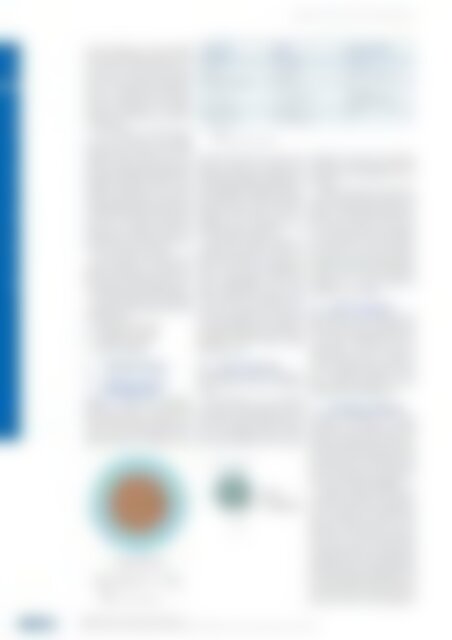You also want an ePaper? Increase the reach of your titles
YUMPU automatically turns print PDFs into web optimized ePapers that Google loves.
<strong>atw</strong> Vol. 63 (<strong>2018</strong>) | Issue 8/9 ı August/September<br />
474<br />
AMNT <strong>2018</strong> | YOUNG SCIENTISTS' WORKSHOP<br />
corium resulting in a porous rubble<br />
structure that mainly consists of fuel<br />
and control rods. If this porous structure<br />
enters in contact with the right<br />
amount of water acting as moderator,<br />
there is a potential for recriticality.<br />
In order to avoid recriticality and its<br />
adverse consequences, a criticality<br />
evaluation of the debris bed needs to<br />
be carried out.<br />
The conditions of the debris bed<br />
can be very diverse and strongly<br />
depend on the accident scenario. The<br />
criticality safety control of the fuel<br />
debris is a challenge principally due to<br />
the large uncertainty of the fuel debris<br />
conditions (location, geometry, composition,<br />
temperature, etc.). Severe<br />
accident codes are able to simulate the<br />
accident progression and can be used<br />
to estimate the debris bed conditions,<br />
however, an adequate observation,<br />
sample taking and analysis of the real<br />
fuel debris are crucial to perform an<br />
accurate criticality evaluation.<br />
Due to the high uncertainty of fuel<br />
debris properties, it is necessary to<br />
prepare a comprehensive and extensive<br />
database, which embraces criticality<br />
data of any possible debris bed.<br />
The main factors on the criticality<br />
evaluation of the fuel debris after a SA<br />
are listed below:<br />
• Total amount of corium<br />
• Composition of corium<br />
• Fuel debris geometry<br />
• Coolant conditions<br />
3 Calculation model<br />
3.1 Geometrical model<br />
of the debris bed<br />
Figure 1 shows the conceptual<br />
geometric model of the debris bed<br />
for the Monte Carlo criticality calculations.<br />
The innermost region of the<br />
model represents the debris itself, as a<br />
porous structure consisting of fuel<br />
| | Fig. 1.<br />
Geometric model of debris bed.<br />
Parameter Range Boundary value<br />
Particle size 1 to 14 mm 10.7 mm<br />
Porosity 0.32 to 0.8 Optimum Porosity<br />
Water void fraction 0 to 90 % 0<br />
Fuel burnup 0 to 60 GWd/t HM<br />
25.8 GWd/t HM<br />
(accident conditions)<br />
Debris bed size 10 to 200 cm 200 cm<br />
Water boration 0 to 2,000 ppm B 0<br />
| | Tab. 1.<br />
Criticality parameters and ranges.<br />
particles and water. For conservative<br />
results, the shape of the debris was<br />
spherically arranged minimizing the<br />
neutron leakage and the critical mass.<br />
Surrounding the fuel debris there is a<br />
water reflector of effectively infinite<br />
thickness (approx. 30 cm). Such configuration<br />
was already used for a<br />
criticality safety evaluation for the<br />
TMI-2 safe fuel mass limit [5].<br />
Debris beds comprise particles of<br />
different shapes and sizes, which are<br />
chaotically arranged in the space. In<br />
order to reduce the computational<br />
effort for the criticality calculations,<br />
some simplifications have been<br />
applied to model the porous structure<br />
of the debris: the particles were<br />
assumed to be spherical, all the particles<br />
were assumed to have the same<br />
size and the particles were assumed to<br />
be regularly distributed in the space<br />
following a Body Centered Cubic<br />
(BCC) lattice [6].<br />
3.2 Corium composition<br />
In this study, the Unit 1 of Fukushima<br />
Daiichi NPP was used as reference<br />
[7, 8].<br />
Conservatively, it was assumed<br />
that there was nothing present in the<br />
fuel debris but fuel pellets and water.<br />
Thus, the negative reactivity effects<br />
due to the possible presence of cladding,<br />
fixed absorbers and structural<br />
materials are ignored. As boundary<br />
conditions, room temperature and a<br />
fuel density of 10.4 g/cm 3 are considered.<br />
ORIGEN 2.1 [9] was used to calculate<br />
the radionuclide inventory for<br />
different average burnups, from fresh<br />
fuel up to a burnup of 60 GWd/t HM .<br />
The average burnup in the reactor of<br />
Unit 1 at the moment of the accident<br />
was calculated to be 25.8 GWd/t HM<br />
[8] and was used as reference model.<br />
To perform the burnup calculations,<br />
fresh fuel UO 2 with an initial enrichment<br />
of 3.7 % wt 235 U was irradiated<br />
considering a specific power of<br />
20 MW/t HM in the reactor.<br />
3.3 Coolant composition<br />
Light water is used as moderator. The<br />
density of the water (or void fraction)<br />
was varied to analyse the influence on<br />
the neutron multiplication factor.<br />
Additionally, boron was added in<br />
every scenario in order to know the<br />
required concentration that guarantee<br />
a subcritical condition of the<br />
debris. Room temperature was considered<br />
for all the calculations.<br />
4 Criticality calculations<br />
Criticality calculations have been<br />
performed for multiple scenarios<br />
using the calculation model described<br />
before. Six parameters have been considered<br />
for these calculations: particle<br />
size, porosity, water void fraction, fuel<br />
burnup, debris size and water boration.<br />
The parameters and ranges of<br />
variation are resumed in Table 1.<br />
In order to analyse all the possible<br />
dependencies between these parameters,<br />
they all have been combined by<br />
pairs, resulting in 15 possible combinations<br />
or calculations sets. In each<br />
calculation set, the paired parameters<br />
have been varied over their whole<br />
ranges, giving to the rest of parameters<br />
a boundary value. The neutron multiplication<br />
factor k eff was then calculated<br />
for all the possible combinations. All<br />
the boundary values have been chosen<br />
to be conservative, except the burnup,<br />
where the value at the moment of<br />
AMNT <strong>2018</strong> | Young Scientists' Workshop<br />
A Preliminary Conservative Criticality Assessment of Fukushima Unit 1 Debris Bed ı María Freiría López, Michael Buck and Jörg Starflinger

















